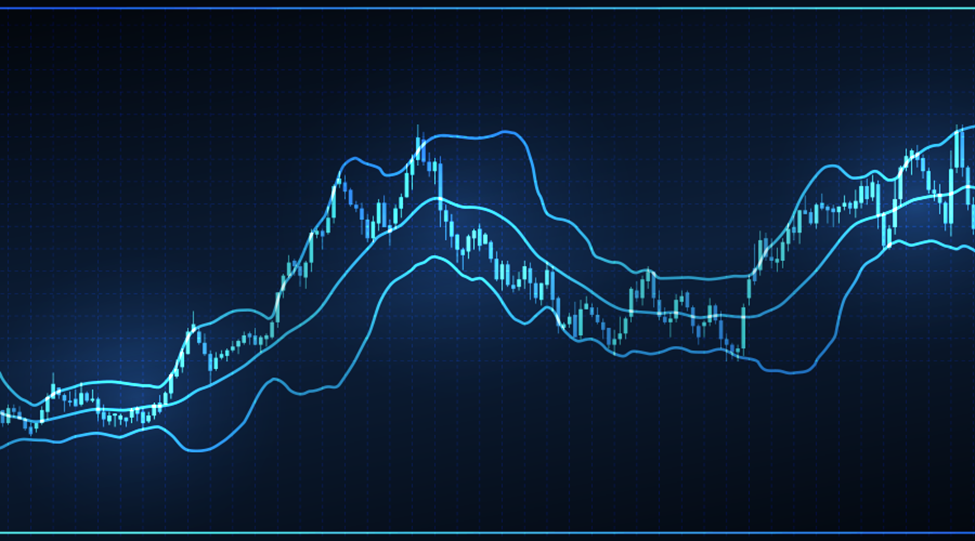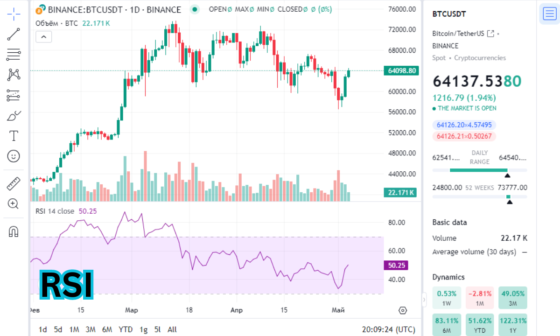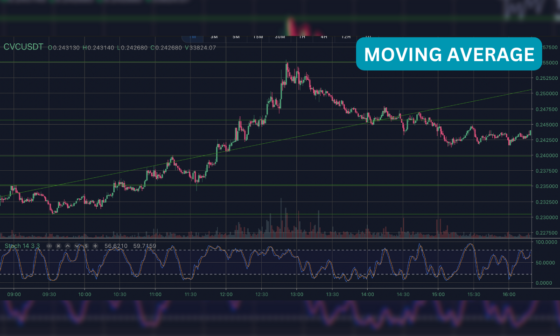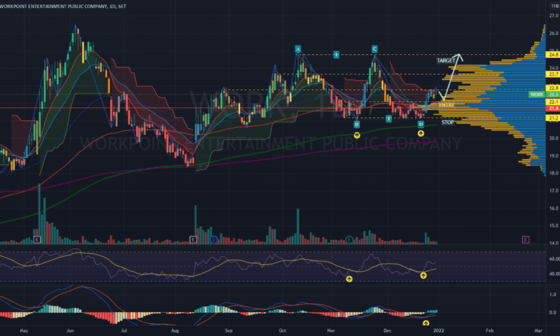What is MA? This is a question that has been asked by traders for many years. Moving Averages (MA) are one of the most popular technical analysis indicators used in Forex, Crypto and stock trading. They are simple to understand and can be very effective when used correctly.
In this block post, we will explore what moving averages are, how they are calculated and how to use them in your trading. So let’s get started!
What is Moving Average?
Moving averages show the average of data points (usually prices) over a time period. The moving average combines price data points to smooth it into trend orientated indicators. It does not predict price direction rather it determines price current direction. Although moving averages can improve price action, they also remove noise from market activity. Moving average is an easy way of analyzing a data set. The moving average may prove particularly useful in determining how much noise and trends have accumulated.
A moving average of asset price is a time series of numbers — it’s a moving average price. Normal movement in an asset may sometimes be volatile, resulting in difficult test for detecting patterns.
The moving average may serve as a trend direction indicator or define potential resistances and supports to the trend in a given region.
Understanding a Moving Average (MA)
The moving average indicator is used in analyzing a security price to determine its trend line direction or its resistance level.
The MA is a trend-following and lag indicator, because the price has changed over time. The longer the average time, the more lag. Generally a 200-day MA has a much higher lag than a 20-day MA since it has prices from previous days.
Moving averages are widely followed and they are important trading indicators for investors. Investors can select a period of varying length and calculate the moving average for the different purpose.
Moving averages in action
Moving averages for different timeframes offer a wealth of information. EMAs can be regarded a smoothing tool – especially for the analysis of long-term trends. Short moving averages are more closely linked to current price action and are therefore frequently compared for short-run analysis and predicting future trending events.
Moving averages serve as support and resistance markers and are also used often as short-term price targets and key points.
What are moving averages used for?
Moving averages are used widely by technical analysts primarily focusing on how to identify and profit from the price movements of stock prices and index movements. Often technical analysts use moving averages to detect a shift in momentum on a security, like when there is a sudden downturn in price of security. They might also be using moving average data to test the suspicion of a potential shift to the current situation.
What are the 4 major moving averages?
The four major moving averages are the Simple Moving Average (SMA), Exponential Moving Average (EMA), Weighted Moving Average (WMA), and Linear Weighted Moving Average (LWMA).
Each of these moving averages has its own strengths and weaknesses, so it’s important to understand the differences between them before making a decision about which one to use. The SMA is the simplest of the moving averages, and it’s often used as a reference point for other moving averages.
The EMA is more responsive to recent price changes than the SMA, making it a good choice for short-term traders.
The WMA puts more weight on recent data points than the SMA, making it more responsive to short-term price movements.
The LWMA is similar to the WMA, but it gives less weight to extreme price changes, making it a more reliable indicator for long-term trends.
Exponential Moving Average VS. Simple Moving Average
As any experienced trader knows, moving averages are one of the most essential tools in technical analysis. A moving average is simply a way of smoothing out data to get a clear picture of the underlying trend.
There are two main types of moving averages: exponential and simple. Exponential moving averages place more weight on recent data, which makes them more responsive to changes in the underlying trend. Simple moving averages, on the other hand, give equal weight to all data points, making them more stable but less responsive to changes.
Both types of moving averages have their advantages and disadvantages, and which one you use will depend on your trading style and goals.
However, many traders find that using a combination of both exponential and simple moving averages is the best way to get a clear picture of the market.
Example of moving averages
Moving averages are a technical analysis tool often used by traders to identify market trends. There are different types of moving averages, but the most common are simple moving averages (SMAs).
SMAs are calculated by taking the average closing price of a security over a specified time period. For example, a 10-day SMA would be calculated by adding together the closing prices from the past 10 days and divide by 10. SMAs are useful because they smooth out short-term price volatility, making it easier to identify underlying trends.
Different time periods can be used to create moving averages, but longer time periods tend to be more accurate at identifying long-term trends.
As with any technical indicator, moving averages should be used in conjunction with other tools in order to make more informed trading decisions.
What does a moving average tell you?
A moving average is a technical analysis indicator that helps smooth out price action by filtering out the “noise” from random price fluctuations. It is created by averaging out past prices over a specific time period, and then plotting that data as a line on a chart.
Moving averages are one of the most popular indicators among traders, as they can provide valuable insights into the underlying trend of a security. For example, if the price of a security is consistently above its moving average, it is generally considered to be in an uptrend. Conversely, if the price is consistently below its moving average, it is typically considered to be in a downtrend.
Moving averages can also be used to identify potential support and resistance levels, as well as to generate buy and sell signals. As such, they are an essential tool for any trader who wants to improve their success rate.
Which moving averages are best?
Moving averages are one of the most commonly used technical indicators in trading. But with so many different moving average strategies out there, it can be tough to know which one is right for you. There are three main types of moving averages – simple, exponential, and weighted – and each has its own advantages and disadvantages.
Simple moving averages are the easiest to calculate, but they can be slow to react to changes in price.
Exponential moving averages are more responsive, but they can be more prone to false signals.
Weighted moving averages strike a balance between the two, but they can be more difficult to interpret.
Ultimately, there is no “best” moving average – it all depends on your individual trading style and objectives. The best way to find out is to experiment with all three types and see which one works best for you.
The golden cross and the death cross
In combination two Moving Averages can generate signals when moving average crossovers happens.
As a trader, you’re always looking for ways to identify market trends and make profitable trades.
Two trading signals that can be helpful in this regard are the golden cross and the death cross. The golden cross occurs when a shorter-term moving average crosses above a longer-term moving average. This is often seen as a bullish signal, indicating that the market is poised for an upswing. Similarly, the death cross happens when the shorter moving average crosses below the longer moving average. While this is generally seen as a bearish signal, it can also indicate that a market trend is about to reverse.
Either way, being aware of these technical indicators can help you make better-informed trading decisions.
What is the 200-day moving average rule?
The 200-day moving average rule is a popular trading strategy that is based on the principle of stock prices tending to move in the same direction as the overall market.
The strategy calls for investors to buy stocks when they trade above their 200-day moving average, and sell them when they trade below it. While there is no guarantee of success, the 200-day moving average rule has been shown to be a effective way to profit from market trends. In addition, the 200-day moving average can also be used as a tool for identifying support and resistance levels, as well as for setting stop-loss orders.
What is MACD?
MACD stands for moving average convergence divergence. MACD is a technical analysis indicator that summarizes changes in the direction, momentum, and duration of a security’s price movements.
It is mainly used to measure the strength of trends and identify potential trend reversals.
The MACD indicator is calculated by subtracting the 26-day exponential moving average (EMA) from the 12-day EMA. A nine-day EMA of the MACD, called the “signal line”, is then plotted on top of the MACD line, which can function as a trigger for buy and sell signals. MACD is considered to be one of the most reliable indicators by traders because it has a long track record of success in trading stocks, commodities, futures, and more.
Using Moving average with Other Technical Indicators
Moving averages are a popular technical indicator that traders use to help identify the direction of the market. Moving averages can also be used in conjunction with other technical indicators to help confirm trading signals. For example, if the moving average is rising and the price action is above the moving average, this may be a sign that the market is in an uptrend. Conversely, if the moving average is falling and the price action is below the moving average, this may be a sign that the market is in a downtrend. By using moving averages in conjunction with other technical indicators, traders can gain a better understanding of the market and make more informed trading decisions.
Limitations of Moving Averages
When assessing the stock market, traders often turn to moving averages as a way to gauge momentum and identify potential trend changes. However, it is important to be aware of the limitations of this tool. First of all, moving averages only provide a snapshot of past prices and do not take into account the fundamental factors that drive price movements. In addition, they can be subject to false signals in choppy markets. Finally, moving averages are lagging indicators, meaning that they will only confirm a trend change after it has already occurred. Despite these limitations, moving averages can still be a valuable tool for traders if used correctly. By being aware of their shortcomings, traders can avoid making costly mistakes.
Conclusion
Now that you know what moving averages are and how they can be used to your advantage, it’s time to start incorporating them into your trading strategy.
If you’re not sure where to start, or if you want to learn from a successful trader, subscribe to our MA based trading strategies for free. You’ll get access to exclusive content, including tutorials, webinars, and more.
Ready to take your trading game up a notch? Subscribe now and start using moving averages like a pro!







